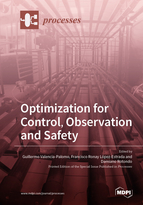Optimization for Control, Observation and Safety
A special issue of Processes (ISSN 2227-9717). This special issue belongs to the section "Automation Control Systems".
Deadline for manuscript submissions: closed (30 September 2019) | Viewed by 94759
Special Issue Editors
Interests: predictive control; optimization; LPV systems; fault detection and isolation
Special Issues, Collections and Topics in MDPI journals
Interests: control applications; optimization; LMIs; Takagi–Sugeno; fault diagnosis
Special Issues, Collections and Topics in MDPI journals
Interests: gain-scheduled control systems; fault detection and isolation (FDI) and fault tolerant control (FTC) of dynamic systems
Special Issue Information
Dear Colleagues,
Mathematical optimization is the selection of the best element in a set with respect to a given criterion. Optimization has become one of the most commonly used tools in modern control theory to compute control laws, adjust the controller parameters (tuning), estimate unmeasured states, find suitable conditions in order to fulfill a given closed-loop property, carry out model fitting, among others. Optimization is also used in the design of fault detection and isolation systems, due to the complexity of automated installations and to prevent safety hazards and huge production losses that require the detection and identification of any kind of fault, as early as possible, as well as the minimization of their impacts by implementing real-time fault detection and fault-tolerant operations systems where optimization algorithms play an important role. Recently, it has been proved that many optimization problems with convex objective functions and linear matrix inequality (LMI) constraints can easily be solved efficiently using existing software, which increases the flexibility and applicability of the control algorithms. Therefore, real-world control systems need to comply with several conditions and constraints that have to be taken into account in the problem formulation, which represents a challenge in the application of the optimization algorithms.
In this SI call, the aim is to offer an overview of the state-of-the-art of the most advanced (online and offline) optimization techniques and their applications in control engineering. Potential topics include (but are not limited to):
- Optimal control of linear and nonlinear systems;
- Optimal control of complex systems;
- Predictive control;
- Optimal observer design;
- Numerical optimization;
- Convex optimization through linear matrix inequalities;
- Evolutionary optimization;
- Constrained optimization;
- Takagi–Sugeno systems;
- LPV systems;
- Fault detection and isolation;
- Fault tolerant control.
Prof. Dr. Guillermo Valencia-Palomo
Prof. Dr. Francisco Ronay López-Estrada
Dr. Damiano Rotondo
Guest Editors
Manuscript Submission Information
Manuscripts should be submitted online at www.mdpi.com by registering and logging in to this website. Once you are registered, click here to go to the submission form. Manuscripts can be submitted until the deadline. All submissions that pass pre-check are peer-reviewed. Accepted papers will be published continuously in the journal (as soon as accepted) and will be listed together on the special issue website. Research articles, review articles as well as short communications are invited. For planned papers, a title and short abstract (about 100 words) can be sent to the Editorial Office for announcement on this website.
Submitted manuscripts should not have been published previously, nor be under consideration for publication elsewhere (except conference proceedings papers). All manuscripts are thoroughly refereed through a single-blind peer-review process. A guide for authors and other relevant information for submission of manuscripts is available on the Instructions for Authors page. Processes is an international peer-reviewed open access monthly journal published by MDPI.
Please visit the Instructions for Authors page before submitting a manuscript. The Article Processing Charge (APC) for publication in this open access journal is 2400 CHF (Swiss Francs). Submitted papers should be well formatted and use good English. Authors may use MDPI's English editing service prior to publication or during author revisions.
Keywords
- optimal control
- predictive control
- nonlinear systems
- complex systems
- observer design
- numerical optimization
- evolutionary optimization
- LMIs
- constrained optimization
- distributed control
- distributed optimization
- LPV systems
- fault detection and isolation
- fault-tolerant control








